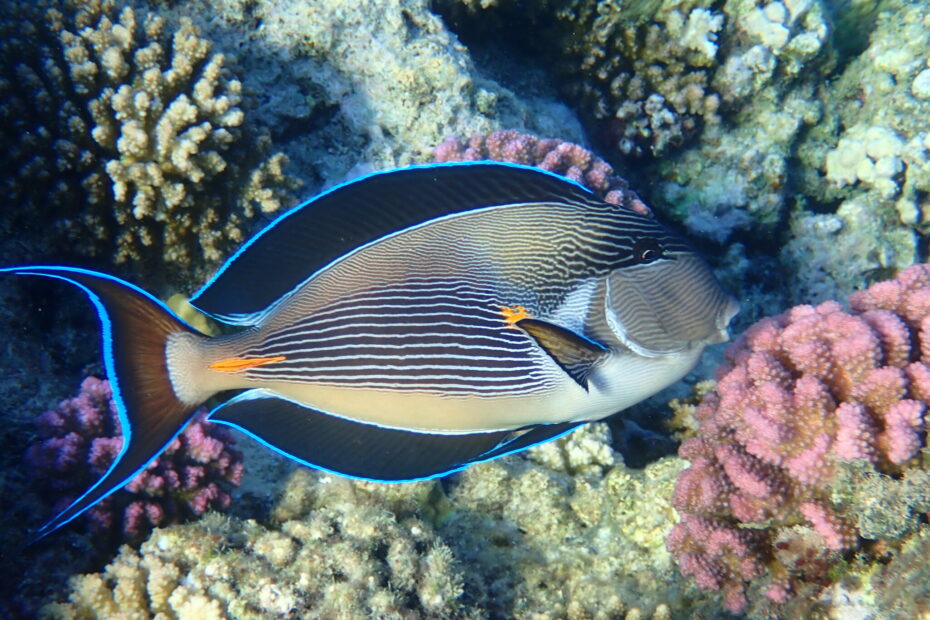Acanthurus sohal (Sohal Tang / Red Sea Clown Tang)
• Small fish safe: ✅ Yes
• Small invert safe: ✅ Yes
• Coral safe: ✅ Yes
• Minimum tank size: 600L+ (Preferably 1000L+ for adults)
• Adult size: ~40 cm
• Diet: Herbivorous (marine algae, seaweed, spirulina-based flakes/pellets, occasional meaty foods)
• Be aware of: Highly aggressive and territorial, especially toward other tangs and herbivores. Requires a large tank with plenty of swimming space. Can become dominant and bully tank mates if space is limited.
Sohal Tang (Acanthurus sohal) – A Stunning but Aggressive Reef Predator
The Sohal Tang, also known as the Red Sea Clown Tang, is one of the most striking and aggressive tang species in the Acanthuridae family. Native to the Red Sea and western Indian Ocean, it is known for its bold black-and-white stripes, electric blue highlights, and vibrant orange accents on the fins. While incredibly beautiful and active, this species is also highly territorial, requiring an exceptionally large tank and careful planning when selecting tank mates.
Appearance and Coloration
The Sohal Tang has a distinctive striped pattern that runs horizontally across its body, creating a bold contrast of black, white, and blue hues. Its tail fin is adorned with bright orange markings, which can become more intense when the fish is stressed or in a dominant state. Like all Acanthurus tangs, it features a sharp scalpel-like spine at the base of its tail, which it uses for defense and territorial disputes.
As one of the largest and most aggressive tang species, it is often regarded as the “boss fish” in large marine aquariums.
Natural Habitat and Behaviour
Sohal Tangs are found exclusively in the Red Sea and western Indian Ocean, where they inhabit coral reefs, rocky slopes, and surge zones. In the wild, they:
• Patrol large territories, often chasing away intruders.
• Graze on algae-covered rocks throughout the day.
• Swim constantly, requiring vast open spaces.
Due to their aggressive and dominant nature, they are often seen fighting off competitors, including other tangs and herbivorous fish.
Tank Requirements and Water Parameters
Because of their large size and highly active swimming habits, Sohal Tangs need an extremely spacious and well-maintained aquarium.
• Minimum tank size: 600L+ (1000L+ recommended for adults)
• Temperature: 23–26°C
• pH: 8.1–8.4
• Salinity: 1.020–1.025
• Water movement: Strong currents and high oxygenation are preferred.
• Filtration: High-capacity filtration and protein skimming are essential to handle their high metabolism and waste production.
A long tank (at least 8 feet in length) is recommended to accommodate their constant movement and reduce aggression toward tank mates.
Diet and Feeding
Sohal Tangs are primarily herbivores, but they have an aggressive feeding style and will often outcompete slower fish for food. To maintain their health and prevent aggression, they should be fed multiple times per day.
Recommended foods include:
• Dried seaweed (Nori) – Essential for digestive health and coloration.
• Spirulina-based flakes and pellets – Provides essential nutrients.
• Fresh macroalgae – Such as chaetomorpha or gracilaria.
• Occasional meaty foods – Enriched mysis shrimp, krill, and brine shrimp.
A high-fiber diet rich in marine algae is crucial to prevent digestive issues and maintain optimal coloration.
Compatibility and Tank Mates
Sohal Tangs are one of the most aggressive tang species, making them difficult to keep with other large herbivorous fish. They will actively chase, bully, or fight similar species, especially in tanks smaller than 1000L.
Best tank mates include:
✔ Large angelfish (Emperor Angelfish, French Angelfish)
✔ Wrasses (Harlequin Tusk, Bird Wrasse)
✔ Groupers and larger reef-safe fish
✔ Fast-swimming, semi-aggressive species (Foxface Rabbitfish, larger triggers)
Avoid housing with:
❌ Other Acanthurus tangs (especially Clown Tang, Achilles Tang, and Powder Blue Tang)
❌ Other large herbivores that may challenge their dominance (e.g., Naso Tangs)
❌ Small, timid fish that may be bullied or outcompeted for food
If mixing tangs, introduce them all simultaneously in a very large tank to reduce aggression.
Health and Disease Considerations
Despite their aggressive nature, Sohal Tangs are fairly hardy if provided with proper care and space. However, like all tangs, they are prone to:
• Marine ich (Cryptocaryon irritans) – Due to their stress-prone nature, they should be quarantined before introduction.
• Head and Lateral Line Erosion (HLLE) – Caused by poor diet, vitamin deficiencies, or suboptimal water quality.
• Fin damage from fights – They are highly territorial and may injure themselves or others during disputes.
To maintain their health:
✔ Provide a spacious, stable environment to reduce stress.
✔ Offer a well-balanced diet with marine algae to prevent deficiencies.
✔ Quarantine new additions to prevent disease outbreaks.
Lifespan and Long-Term Care
With proper care, Sohal Tangs can live up to 15 years or more in captivity. Their intelligence, striking appearance, and active swimming style make them a true showpiece fish for dedicated marine aquarists.
Why Choose a Sohal Tang?
✔ One of the most visually striking tangs – Bold stripes, blue highlights, and orange accents.
✔ Highly active and intelligent – Constantly swimming and exploring.
✔ Excellent algae grazer – Helps control algae growth.
✔ Long lifespan – Can live over 15 years with proper care.
⚠ Important Considerations Before Buying a Sohal Tang:
🚫 Not for beginners – Requires expert-level care and planning.
🚫 Needs a very large tank – Smaller tanks will lead to aggression and stress.
🚫 Highly aggressive – May not tolerate other tangs or herbivores.
